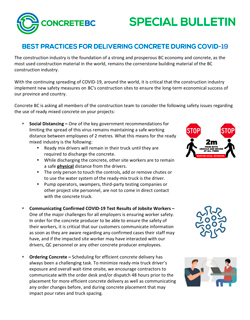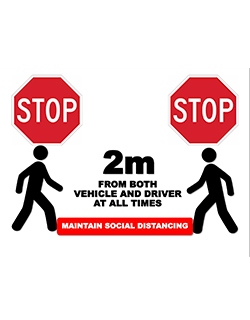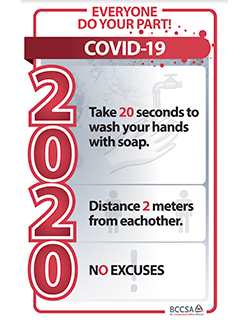SAFETY
It’s not expensive…it’s priceless!
COVID-19 Best Practices
H & S Guidelines for Employees in the Construction Industry
Concrete BC has compiled some of the recommendations that health and safety organizations and concrete companies are implementing where the construction sector continues to operate, with the objective of mitigating or minimizing the risk of transmission of the virus to industry personnel.
Required Certification
Concrete Pump Operator Certification (CCPO)
Concrete BC, working together with the BC Construction Safety Alliance (BCCSA) and WorkSafeBC, enhanced safety in concrete pump operations in the province with the implementation of the Certified Concrete Pump Operator Certification (CCPO). Operators with CCPO have demonstrated theoretical knowledge of concrete pump operations and they have shown they can apply this knowledge by working competently in the field through both Online Testing and In-Person Practical Evaluations.
Effective January 1, 2024, concrete pump operators in BC are required to hold a valid certification for the pump type they currently operate, as per recent changes to BC’s Occupational Health & Safety Regulations. The Certified Concrete Pump Operator (CCPO) certification is a professional accreditation delivered by the BCCSA.
This certification program is a collaboration by industry (Concrete BC) and safety professionals to ensure holders of the certification are operating to a standard of high competence – one of safety, environmental consideration, and value.
You can find more info about CCPO here: https://www.ccpo.ca
Safety Training Manual
For Concrete Pump Operators
Produced by Concrete BC, this manual, published in the spring of 2009, and updated in January 2016, sets a basic safety training standard for concrete pump operators in British Columbia. This manual is the foundation for the pump operator safety training workshops delivered by Concrete BC, and a student copy is included for the Pump Operator Safety Training workshop.
Injury Management
Handbook
This handbook contains information that will help supervisors familiarize themselves with key responsibilities within injury management and understand why such involvement is important. Practical tools are also contained in the handbook to assist supervisors in executing their responsibilities.
If you have any questions or would like to obtain hard copies of this publication, please contact Alicia Brady, Communications Program Coordinator, Construction Safety Network, at 604-636-3679.
Inclement Weather Guidelines
Safety Awareness
The purpose of these guidelines is to ensure that lightning safety awareness is a priority for employees in all outdoor activities. There is no location outdoors that is 100% safe from lightning strikes, however, being aware of and following proven lightning risk reduction guidelines can lower the risk of injury or death.
Warm or Hot Weather
Working Conditions
As we approach the summer months, working in warm or hot weather must be addressed for all workers.






